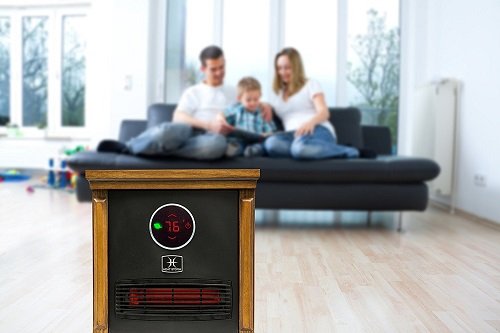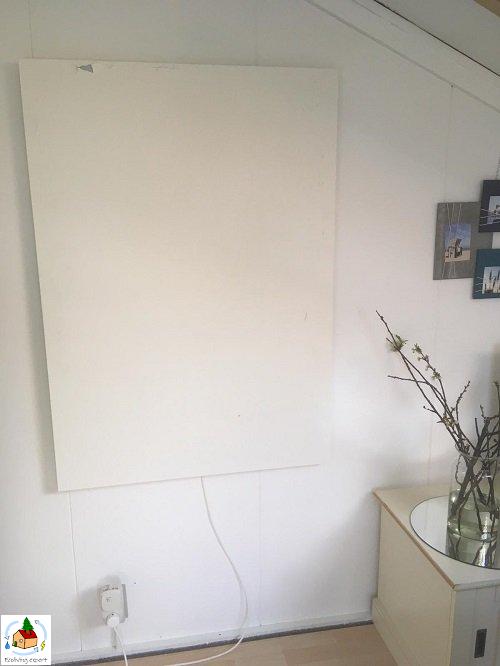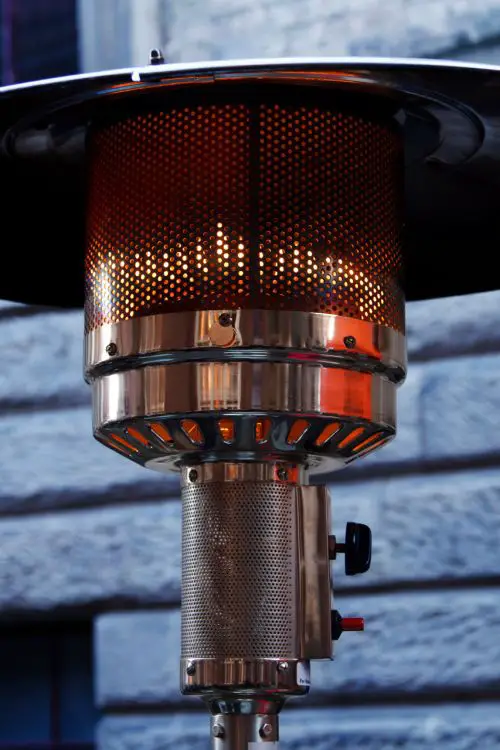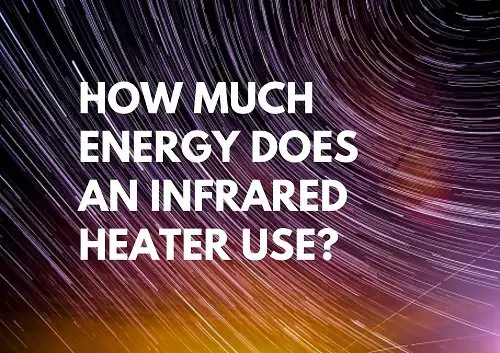A standard infrared heater uses 1500 watts. Infrared heaters use 7 watts per square foot (0.1 m²) compared to 10 watts for standard heaters. To heat an average-sized living room of 330 square feet, 2300 watts of infrared heat is required. Infrared heaters use 30 to 40 % less energy than regular heaters.
Compared to other forms of electric heating such as portable radiant space heaters, infrared heaters are much more efficient. Therefore, they save on electricity use and costs.
Infrared heaters do not heat the air but heat people and objects directly. Therefore, they use about 40% less energy to create the same level of comfort as typical space heaters. In this article, I will discuss the energy use and running costs of different infrared heaters as well as what room size they can heat up.
How much energy do infrared heaters use?
The energy use of an infrared heater is mentioned in watts (W) and can be seen on the packaging. Energy use is also shown on a sticker on the device or a sticker on the power cord. This wattage is the amount of electrical energy that is converted to heat by the heater. It is simultaneously its electricity use and its heat output.

This means that it is irrelevant how the heater looks or what size it is. The mentioned wattage (W) is its energy use and heat production. In this article, I will explain what the costs are per watt and how efficient infrared heaters are. Additionally, I will show what types of infrared heaters are available and how they compare to regular electric space heaters in terms of energy use and heat production.
Infrared heater’s energy use per room
The following table shows the required energy use per room of infrared heaters vs convection-based heaters (typical warm-air-producing heaters). The room sizes are based on typical American room sizes.
| Room | Room size (square feet) | Required wattage (infrared) | Required wattage (convection) |
|---|---|---|---|
| Bedroom | 132 (12 m²) | 594 | 849 |
| Living room | 330 (31 m²) | 2310 | 3300 |
| Bathroom | 160 (15 m²) | 1490 | 2129 |
| Closed porch | 200 (19 m²) | 1860 | 2657 |
| Open outdoor patio | 288 (27 m²) | 8000 – 16000 | Warm air cannot heat an outdoor space |
I made a super handy calculator that easily shows how much wattage of infrared you need. You can simply add the dimensions, type of room, and a guess of how well it’s insulated, and you’ll get a wattage requirement for infrared. You can find it here: Infrared wattage calculator: how many watts do you need for any room?
Infrared heater running costs and maximum room size
The following table shows the energy for different infrared heaters, their running cost per hour, and what room size it can heat up. This table is based on heating a living room. The costs per hour are based on a price of $0.15 per kilowatt-hour.
| Infrared heater (watt) | energy use (kilowatt) | costs per hour | room size heated (square feet) |
|---|---|---|---|
| Infrared panel, 400 W | 0,4 kW | $0.06 | 53 sq. ft (5 m²) |
| Infrared panel, 700 W | 0,7 kW | $0,105 | 93 sq. ft (9 m²) |
| Infrared panel, 1000 W | 1 kW | $0.15 | 133 sq. ft (13 m²) |
| Quartz heater, 750 W | 0,75 kW | $0.113 | 100 sq. ft (10 m²) |
| Quartz heater, 1500 W | 1,5 kW | $0.225 | 200 sq. ft (20 m²) |
The table above is based on heating a living room. Heating requirements differ per room and are shown in Table 3 up next.
For information about the running costs of infrared heaters compared to a gas-based heating system, I recommend my article: The real running costs of infrared heating (compared to gas).
How much space can an infrared heater heat up?
Infrared heaters can heat a room more effectively than other forms of heat. The main difference is that they do not heat the air and therefore no energy loss takes place due to rising warm air. However, infrared heating takes some getting used to, as I will discuss later in this article.
The table below shows exactly how much wattage is needed for different rooms in the house:
| Area | Required wattage per sq. ft (0,1 m²) |
|---|---|
| Living room | 7 W |
| Bedroom | 4,5 W |
| Bathroom | 9,3 W |
| Closed porch | 9,3 W |
| Open outdoor area | 28 – 56 W |
Energy use: infrared vs conventional heating
Infrared heaters use about 7 watts per square foot (0.1 m²) for the living room. For conventional convection-based heaters, the rule of thumb is 10 watts for 1 square foot (0.1 m²). Therefore, infrared heaters are about 40% more efficient than conventional electric convection heaters.
These numbers are based on an average ceiling height of 9 feet. Therefore, 90 cubic feet (2.5 m3) can be heated by 100 watts of conventional heating, and 70 watts of infrared heating.
This means that a 1500 W space heater can heat up a living room of 150 square feet (15 m²). A 1500 W infrared heater can heat up a living room of 215 square feet (21 m²).
There are many more benefits to infrared heaters other than saving energy. You can find my article about all the pros and cons of infrared heating here: Infrared heating pros and cons (and why I love it)
The running costs of a typical 1500-watt infrared heater
The price of electricity is set per kilowatt-hour (kWh) and is on average about $0.15. So, when you run a 1500 W infrared heater for an hour, the costs will be $0.15 x 1.5 kW x 1 hour = $0.225.
You can read all about the running costs of infrared heating in my article: The real running costs of infrared heating.

Infrared heating feels different than conventional heating
Infrared heaters heat up objects and people within a room rather than the air. In this way, they are exceptionally effective at heating. However, they do no warm up the air as much (although warm objects and people will increase the air temperature). Therefore, infrared heating is more like sitting outside in the sun rather than indoors at room temperature.
This might take some getting used to. And during the winter, a blanket covering your legs is a good idea when you are working at your desk.
What types of infrared heaters are available?
There are three types of infrared heaters available:
- infrared heating panels (only applicable indoors)
- portable infrared space heaters (often quartz-based)
- infrared patio heaters suitable for outdoor use
Infrared heating panel energy use, costs, and effectiveness
Infrared heating panels are available in a range of wattages and vary in size based on their energy use and heat output.
I am very enthusiastic about infrared panels for heating and own a 300 W and a 700 W panel to heat my kitchen area. Since there are many sizes of infrared panels, I have made the following table to show what they can do and how much they cost.
| Energy use (W) | size (foot) | running costs per month (4h/day) | heats area of (sq. ft.) | buy price ($) |
|---|---|---|---|---|
| 300 | 2×2 (60×60 cm) | $5,4 | 43 (4 m²) | $190 |
| 330 | 4×1 (125×32 cm) | $5,9 | 47 (4,3 m²) | $200 |
| 400 | 5×1 (150×32 cm) | $7,2 | 57 (5,3 m²) | $207 |
| 700 | 4×2 (120×60 cm) | $12,6 | 100 (9,3 m²) | $267 |
| 850 | 4×2,5 (120×80 cm) | $15,3 | 121 (11,2 m²) | $365 |
| 1000 | 4×3 (120×85 cm) | $18 | 143 (13,3 m²) | $389 |
Based on their size and energy use I have calculated their energy output per square centimeter is just below 0.1 W per cm². This is the same for every panel regardless of their size. So, if you want the best energy output for the price, the largest, most expensive panel is the best choice.
I highly recommend trying an infrared panel yourself, because no words can truly describe the actual experience of indoor sun-like heat. Amazon.com offers excellent infrared panels starting from only 199$, check it out here.

For more information about whether infrared heaters are worth purchasing, I recommend reading my article: Are infrared heaters worth it? (yearly costs, health, and safety)
Portable infrared heaters
Portable infrared heaters are mostly available as 1500 W models. Some have additional options such as low energy use, or eco mode. These options manage the wattage use and therefore the heat output. Normally a low energy use mode uses 750 W.
Outdoor infrared patio heaters
For outdoor heating, much more heat is required. A conventional air-heating heater cannot possibly heat an outdoor space as the warm air would immediately vanish. Infrared heaters are an excellent option for outdoor heating as they can be aimed at objects and people that require heating.
You might be familiar with terrace heaters such as the one shown in the picture below.

As was mentioned in this article, outdoor heating requires a lot of energy. For every square foot outdoors, about 28 to 56 W of electricity is required.



4 thoughts on “Infrared heaters energy use (costs, efficiency, W/sq. ft.)”
Comments are closed.